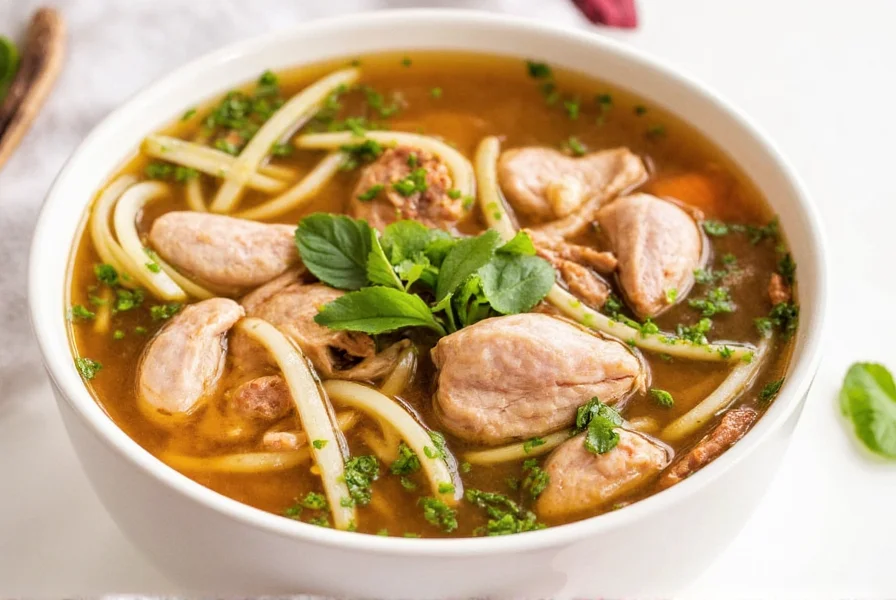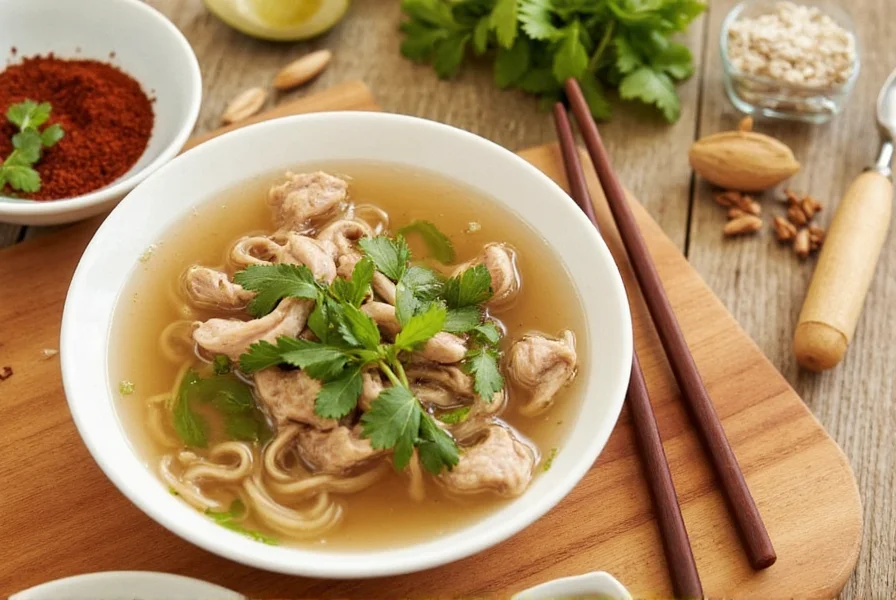The 10 essential spices for chicken pho broth are: Star Anise, Cinnamon, Coriander Seeds, Fennel Seeds, Black Cardamom, Cloves, Peppercorns, Ginger, Garlic, and Rooibos Tea. Each plays a critical role in creating the authentic, complex flavor profile of Vietnamese chicken pho.
| Spice | Flavor Profile | Use Case | Substitutes |
|---|---|---|---|
| Star Anise | Sweet, licorice-like | Essential base | Anise seeds (less potent) |
| Cinnamon | Warm, woody, sweet | Balances heat and bitterness | Nutmeg or allspice |
| Coriander Seeds | Earthy, lemony | Foundation of spice blend | Ground coriander (less fragrant) |
| Fennel Seeds | Mild licorice, herbal | Complements anise | Dill seed (milder flavor) |
| Black Cardamom | Smoky, camphor-like | Adds complexity | Green cardamom (milder and sweeter) |
| Cloves | Intense, bitter-sweet | Used in small amounts | Allspice (milder flavor) |
| Peppercorns | Heat with floral notes | Adjustable spiciness | Crushed red pepper flakes |
| Ginger | Spicy, sharp, fresh | Boiled or charred | Ginger paste |
| Garlic | Pungent, savory | Roasted or raw | Garlic powder (not ideal) |
| Rooibos Tea | Earthy, reddish hue | Optional for coloring and depth | Hibiscus or black tea |
Chicken pho isn't just about noodles and broth—it's about depth. The spices used in the broth layer complexity, warmth, and aroma into every spoonful. Unlike other soups, where herbs and salt might be enough, pho relies heavily on a unique blend of spices to build its signature flavor profile.
The key is balance: sweet, savory, earthy, and floral notes all need to shine without overpowering each other. When done right, your kitchen will smell like a bustling street market in Hanoi before you've even taken the first bite.
Table of Contents
- Why Spices Matter in Chicken Pho
- Top 10 Spices for Chicken Pho
- How to Use These Spices in Your Pho
- Buying Guide: Choosing Quality Spices
- Common Mistakes to Avoid
- Frequently Asked Questions
- Conclusion
Why Spices Matter in Chicken Pho
Chicken pho isn't just about noodles and broth—it's about depth. The spices used in the broth layer complexity, warmth, and aroma into every spoonful. Unlike other soups, where herbs and salt might be enough, pho relies heavily on a unique blend of spices to build its signature flavor profile.
The key is balance: sweet, savory, earthy, and floral notes all need to shine without overpowering each other. When done right, your kitchen will smell like a bustling street market in Hanoi before you've even taken the first bite.
Top 10 Spices for Chicken Pho
Here's the breakdown of the spices that belong in your chicken pho arsenal:
- Star Anise – The backbone of pho's aroma.
- Cinnamon (Cassia) – Adds warmth and sweetness.
- Coriander Seeds – Earthy and citrusy undertones.
- Fennel Seeds – Mild licorice flavor that complements anise.
- Black Cardamom – Smoky and intense; use sparingly.
- Whole Cloves – Intensely aromatic and slightly bitter.
- Peppercorns (Black & Sichuan) – Heat with subtle fruitiness.
- Ginger – Brightens the broth and cuts through richness.
- Garlic – Deep umami and pungency.
- Rooibos Tea – Optional for color and earthiness.
How to Use These Spices in Your Pho Broth
Using spices effectively in pho involves more than tossing them into boiling water. Here's how to make the most out of each ingredient:
Step 1: Toast the Whole Spices
Before adding to the broth, toast whole spices like star anise, cloves, cinnamon sticks, coriander seeds, fennel seeds, and peppercorns in a dry skillet over medium heat until fragrant. This unlocks their essential oils and intensifies the flavor.
Step 2: Char Aromatics Like Ginger and Garlic
Charring ginger and garlic adds smokiness and depth. Simply place them over an open flame or under the broiler until the skins blister and blacken slightly. This step gives your pho that unmistakable street-food edge.
Step 3: Add Early in the Cooking Process
Because they're whole, spices need time to infuse the broth properly. Add them early in the cooking process, ideally within the first hour of simmering. Simmering allows flavors to meld gradually without burning off delicate aromas.
Step 4: Strain Before Serving
While you want the spices' flavor, you don't want to eat them. Strain the broth thoroughly before serving. A fine mesh sieve lined with cheesecloth ensures no stray clove or peppercorn sneaks into your bowl.
Step 5: Taste and Adjust
Taste as you go. Some batches may benefit from a touch more cinnamon for sweetness or extra ginger for brightness. Don't be afraid to adjust the seasoning—you're crafting a personal masterpiece!
Buying Guide: Choosing Quality Spices for Chicken Pho
Quality matters when it comes to spices. Here's what to look for when purchasing ingredients for your homemade pho broth:
- Freshness: Whole spices last longer than ground ones. Look for vibrant colors and strong aromas.
- Origin: Ceylon cinnamon, Indonesian star anise, and Indian coriander are known for superior quality.
- Organic Options: If possible, choose organic spices to avoid unnecessary chemicals.
- Brand Recommendations: Look for brands like Penzeys, Spice Island, or local Asian markets that specialize in authentic ingredients.
Recommended Products
Penzeys Star Anise
Known for bold flavor and perfect for building pho base. Ideal for both professional chefs and home cooks.
Spice Island Cassia Cinnamon Sticks
Thicker bark, stronger flavor. Excellent for slow-simmered broths.

Penzeys Coriander Seeds
Highly aromatic with a clean, citrusy taste. Perfect for balancing heavier spices.
Fennel Seeds by Frontier Co-op
Organic, non-GMO, and sustainably sourced. Ideal for adding herbal sweetness to the broth.
Whole Black Cardamom Pods
Smoky and intense, these pods add depth. Use sparingly to avoid overpowering the broth.
Common Mistakes to Avoid When Using Spices in Pho
Even experienced cooks can make missteps when using spices in chicken pho. Here are some common mistakes and how to avoid them:
- Overloading cloves or cardamom: These spices are powerful—start with fewer and adjust later.
- Skipping the toasting step: Toasting releases flavor compounds and makes a noticeable difference.
- Using old or stale spices: Old spices lose potency. Replace them every 6–12 months.
- Not roasting garlic or charring ginger: Roasting garlic and charring ginger unlock complex flavors that elevate the broth.
- Adding all spices at once: Layering flavors works best. Add some early and others later if needed.
Frequently Asked Questions About Spices for Chicken Pho
Here are answers to some common questions about using spices in chicken pho broth:
What's the most important spice in chicken pho?
Star anise is considered the backbone of pho's distinctive aroma. While all spices work together in harmony, star anise provides that signature licorice-like scent that defines pho. Without it, your broth would lack the characteristic fragrance that makes pho instantly recognizable.
Can I make authentic chicken pho without certain spices?
Yes, but with some compromises. The core spices you shouldn't skip are star anise, cinnamon, and cloves. These create the essential flavor foundation. Substitutes like allspice can work in a pinch, but the authentic pho experience comes from the complete spice ensemble. If you must omit something, black cardamom or rooibos tea are the most optional of the 10 essential spices.
How much of each spice should I use for a standard pot of pho?
For a standard 8-cup batch of broth, use: 3-4 star anise pods, 1 cinnamon stick (about 3 inches), 1 tablespoon coriander seeds, 1 teaspoon fennel seeds, 2-3 black cardamom pods, 4-6 whole cloves, 1 teaspoon mixed peppercorns, one 2-inch piece of ginger, and 2-3 garlic cloves. Remember to toast whole spices first for maximum flavor.
Can I use ground spices instead of whole spices?
Whole spices are strongly recommended for pho. Ground spices will cloud your broth and can become bitter during long simmering. The essential oils in whole spices release slowly, creating a clearer, more nuanced broth. If you must use ground spices, use 1/3 the amount and add them in the last 30 minutes of cooking, but the results won't be as authentic.
What's the difference between spices for chicken pho versus beef pho?
Chicken pho uses a lighter, more delicate spice profile. It typically contains less black cardamom (which is very strong) and sometimes includes rooibos tea for color without the deep richness of beef bones. Beef pho often uses more star anise and black cardamom to stand up to the stronger meat flavor. Chicken pho spices should be balanced to complement, not overpower, the delicate chicken broth.
How can I fix bitter pho broth?
Bitterness usually comes from too many cloves, cardamom, or overcooked spices. To fix it: 1) Remove excess whole spices immediately, 2) Add a small piece of sugar or 1/2 teaspoon of honey to balance bitterness, 3) Add more broth to dilute, or 4) Include a small amount of rooibos tea which can help mask bitterness with its earthy notes. Prevention is best - remember cloves and cardamom are potent, use sparingly.
Can I reuse pho spices for multiple batches?
While you can technically reuse spices once, the flavor will be significantly weaker the second time. Spices for pho are meant to be used fresh for each batch to ensure maximum flavor. The cost of spices is minimal compared to your other ingredients, so it's worth using fresh spices each time for authentic results.
How should I store my pho spices to keep them fresh?
Store whole spices in airtight containers away from light, heat, and moisture. Properly stored, they'll maintain peak freshness for 1-2 years. Avoid storing near your stove or in clear containers on the counter. For longest shelf life, keep them in dark glass jars in a cool pantry. Check freshness by smelling - if the aroma is weak, it's time to replace them.
Why does my pho broth lack depth even with all the spices?
This usually happens when spices aren't properly toasted or aromatics aren't charred. Toasting whole spices in a dry pan before adding to broth unlocks their essential oils. Charring ginger and garlic adds smokiness that's crucial to authentic pho flavor. Also, ensure you're simmering long enough (at least 3-4 hours) for flavors to fully develop and meld together.
What can I substitute for star anise if I can't find it?
Anise seeds are the closest substitute but are less potent (use 1.5x more). Fennel seeds can provide a similar licorice note but are milder. In a pinch, a tiny pinch of Chinese five-spice powder (which contains star anise) can work, but it will add other flavors too. Without star anise, your pho won't have its signature aroma, but these substitutes can help you get closer to the authentic flavor.
Conclusion
Mastering the spices for chicken pho is like unlocking a new level of culinary magic. Each spice contributes something special—be it warmth, depth, or brightness—and when combined, they create a broth that's nothing short of sublime.
With this guide, you now have everything you need to craft your own signature chicken pho at home. Remember: it's not about perfection—it's about personalization. Tweak, taste, and enjoy the journey. Your tastiest bowl of pho is just a pot away!
Happy cooking, and may your kitchen forever smell like the streets of Saigon.











 浙公网安备
33010002000092号
浙公网安备
33010002000092号 浙B2-20120091-4
浙B2-20120091-4